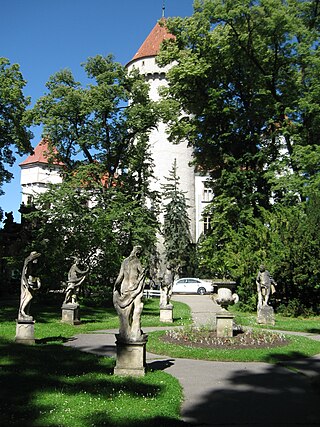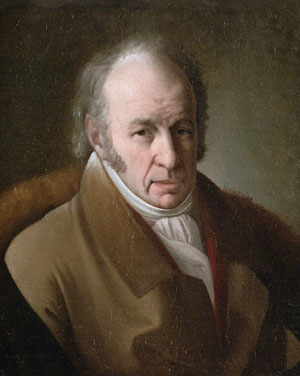
The House of Este is a European dynasty of North Italian origin whose members ruled parts of Italy and Germany for many centuries.

The Chiesa di San Pantaleone Martire, known as San Pantalon in the Venetian dialect, is a church in the Dorsoduro sestiere of Venice, Italy. It is located on the Campo San Pantalon (square), and is dedicated to Saint Pantaleon.

Pisanello, born Antonio di Puccio Pisano or Antonio di Puccio da Cereto, also erroneously called Vittore Pisano by Giorgio Vasari, was one of the most distinguished painters of the early Italian Renaissance and Quattrocento. He was acclaimed by poets such as Guarino da Verona and praised by humanists of his time, who compared him to such illustrious names as Cimabue, Phidias and Praxiteles.

Konopiště Castle is a four-winged, three-storey castle located in Konopiště, now a part of the town of Benešov in Central Bohemian Region, Czech Republic. It has become famous as the last residence of Archduke Franz Ferdinand of Austria, heir to the Austro-Hungarian throne, whose assassination in Sarajevo triggered World War I. The bullet that killed him, fired by Gavrilo Princip, is now an exhibit at the castle's remote museum.

Battaglia Terme is a town and comune in the Veneto region of Italy, in the province of Padua.

Castello del Catajo is a patrician rural palace near the town of Battaglia Terme, province of Padua, north-eastern Italy built in 1573.

Girolamo Romani, known as Romanino, was an Italian High Renaissance painter active in the Veneto and Lombardy, near Brescia. His long career brought forth several different styles.

Giuseppe Bernardino Bison was an itinerant Italian painter of frescoes, landscapes, vedute, capriccios and some religious works.

Giovanni Battista Zelotti was an Italian painter of the late Renaissance, active in Venice and her mainland territories.
Ercole Grandi was an Italian painter of the early-Renaissance period, active mainly in Ferrara. Also known as Ercole da Ferrara and Ercole di Giulio Cesare Grandi, he has been claimed to be a favourite pupil of the painter Lorenzo Costa. Ercole Grandi first appeared in the historical record as being in the service of the house of Este in 1489. Between 1489 and 1495, Ercole Grandi seems to have been working in Bologna, both in San Petronio and in the Cappella Bentivoglio of San Giacomo Maggiore, as an assistant to Lorenzo Costa. In 1495, he was in Ferrara as the chief architect for realising Duke Ercole's plans to embellish the city and renovate the churches; the facade and interior of Santa Maria in Vado were executed from his design. He worked with Ludovico Mazzolino and others on the decoration of the Castello, and painted in the apartments of Lucretia Borgia. Also in Ferrara, he painted the frescoes for the church of San Pietro Martire, although some frescoes are preserved. One problem in assigning attribution to the hand of Ercole Grandi is that none of his works is signed or dated, or accompanied by supporting documents, but he is thought by some scholars to have painted—in the manner of Mantegna—or had a hand in, the decorative frescoed ceiling in the Sala del Tesoro of the Palazzo Costabili in Ferrara between 1503 and 1506. Other scholars attribute the work to Benvenuto Tisi da Garofalo. Confusingly, the identity of Ercole Grandi is sometimes conflated with Garofalo, and an Ercole da Bologna, and with that of Ercole di Antonio Roberti or Ercole de' Roberti, who was first documented as being in Ferrara in 1479, and was author of the great frescoes of the Garganelli chapel in Bologna. Most of Ercole Grandi's works have been reattributed to other Ferrarese painters, such as Giovan Francesco Maineri and Lorenzo Costa, while other scholars insist that Ercole Grandi is a mythical character.
The decade of the 1480s in art involved some significant events.
The decade of the 1450s in art involved many significant events, especially in sculpture.
The decade of the 1440s in art involved some significant events.

Caterina Gabrielli, born Caterina Fatta, was an Italian coloratura singer. She was the most important soprano of her age. A woman of great personal charm and dynamism, Charles Burney referred to her as "the most intelligent and best-bred virtuosa" that he had ever encountered. The excellence of her vocal artistry is reflected in the fact that she was able to secure long-term engagements in three of the most prestigious operatic centers in her day outside of Italy.
Tommaso degli Obizzi, who at one time was thought to be the last of the house of Obizzi, who was born and died at the Castello del Catajo near Padua was a pioneering collector who added to the works of art at Catajo some Italian 'primitives', refined late Gothic works that were far from the current taste. Like his friend Teodoro Correr in Venice, he protected his works of the trecento and quattrocento from the Napoleonic forces in Italy, and they were never sequestered and sent to Paris. The Saint Jerome altarpiece by Antonio Vivarini now in the Kunsthistorisches Museum, Vienna, was purchased by him and eventually passed to the Este in Austria, with other early Italian paintings that made the collection one of the first of its kind in Europe.
Giovanni d'Alemagna was a Venetian renaissance painter of German ancestry, active in Italy, with his brother-in-law Antonio Vivarini on religious paintings in Venice and Padua, that are preserved in the named cities together with those of Vivarini.
Giovanni Felice Sances was an Italian singer and a Baroque composer. He was renowned in Europe during his time.

Venetian painting was a major force in Italian Renaissance painting and beyond. Beginning with the work of Giovanni Bellini and his brother Gentile Bellini and their workshops, the major artists of the Venetian school included Giorgione, Titian, Tintoretto (1518–1594), Paolo Veronese (1528–1588) and Jacopo Bassano (1510–1592) and his sons. Considered to give primacy to colour over line, the tradition of the Venetian school contrasted with the Mannerism prevalent in the rest of Italy. The Venetian style exerted great influence upon the subsequent development of Western painting.

Gerolamo Frigimelica Roberti was an Italian architect, librettist, and poet.

Antonio Gasparinetti was an Italian poet, playwright and military officer in Napoleon's Armée d'Italie. Born in the Province of Treviso, he joined a light cavalry regiment as a lieutenant in 1797 and rose to the rank of colonel by the end of his career in 1814. He distinguished himself in several major battles of the Napoleonic wars, including the Battle of Wagram when he was awarded the Legion of Honor by Napoleon. After the fall of Napoleon in 1814, he was deeply involved in the Congiura di Brescia-Milano, a plot to overthrow Austrian rule in northern Italy. When the conspiracy was discovered, he was arrested and spent nearly four years in prison. Following his release in 1818 he devoted himself to literary pursuits and collecting military memorabilia. Gasparinetti was married to the opera singer Elisabetta Gafforini from 1812 until his death in Milan at the age of 47.












